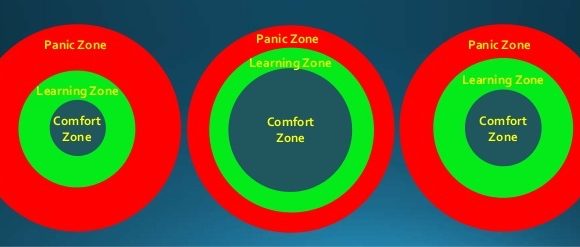The Difference Between The Comfort Zone, The Learning Zone, and the Panic Zone
The other professors and I were reviewing student feedback on our course at the medical school at UT. As usual: lots positive, a few negative, and some mixed. One of the things they heard often was negative feedback from some of the students that my improv exercises made them uncomfortable. This is an interesting bit of feedback: discomfort. And can be a bit of a catch-all that can mean a lot of things. “That made me uncomfortable” could mean that was offensive. It could mean that was new to me. That its outside of the comfort zone I’m in most of the time. That it’s confusing. That it’s socially awkward. Or other potential trespasses. Some of these are very serious and should be taken seriously.
What I hear in that feedback, which I get a lot, is that I push people out of their comfort zone. And to me, as a teacher, I think that’s often a really good thing.
So I pushed back on the feedback. Is it our job as instructors, especially in a medical school, to make the students feel comfortable? I mean, I feel it’s very important to create a safe environment in my classroom. Safe for risk-taking. Safe for failing. Safe for being authentically yourself. Safe to speak up. Safe physically. Safe to hide in. Safe enough to be… uncomfortable?

I saw this slide at a presentation a while back showing these three zones: The Comfort Zone, The Learning Zone and the Panic Zone. And how, as an experiential teacher, she’s trying to get her students into the Learning Zone. In her chart, that is where there is both high psychological safety and high accountability. To me that means people are free to take risks and speak up without fear of rejection or embarrassment, while at the same time, people take responsibility for their behavior and their mistakes.
Let’s take a closer look at these zones.
In the Comfort Zone, you can relax. There is familiarity and routine. There can be a sense of mastery and control. You can refresh and recharge. You can also go on autopilot.
In the Learning Zone is where you are feeling some discomfort. You are dealing with something new. You are growing, stretching, trying to figure something out. There’s a level of discomfort that’s not necessarily unpleasant. You still have access to your brain and logic to think things through.
In the Panic Zone, you are freaking out. You don’t have access to your brain or logic. You get tunnel vision and can’t take in a lot of information. You are trying to survive and in fight or flight mode. It’s hard for you to process anything or put anything into long term.
This is what I explained to the medical students in our first class together for the new year. The same activity for each student could put them in a completely different zone. After I confessed that the discomfort they might be feeling was intentional, they seemed to be easily on board with the activities I presented. I let them know that the discomfort I was going to put them through was not just to torture them, but to teach them something very important.
I shared with them the explanation I learned from Randy Nelson, a Director at Apple University. Why do pilots use flight simulators? Because there are three levels of learning: 1) Knowing what to do. 2) Being able to do it. 3) Being able to do it when you really need to (like when you are on the spot and under pressure.) And that’s what pilots need. And it’s what doctors need. And it’s what improvisers need.

So part of an improv teacher’s job is on the one hand creating an environment that is safe and comfortable, and on the other pushing students out of their comfort zone and into their learning zone. All the while not going so far as putting them all the way in their panic zone. Once they are in their panic zone they can’t learn in that moment, and they are also less likely to learn in the future either because they might not come back or they might be triggered even more quickly into panic the next lesson.
This is part of why I invite my students to participate in increasingly riskier activities over a class and over a course. And why I let them know these activities are voluntary and optional, that they should take care of themselves and their bodies and feel free to step out or modify any activity. Everyone’s comfort, learning, and panic zones are different, so it’s hard to get everyone in the right zone without their own participation and self-regulation.

